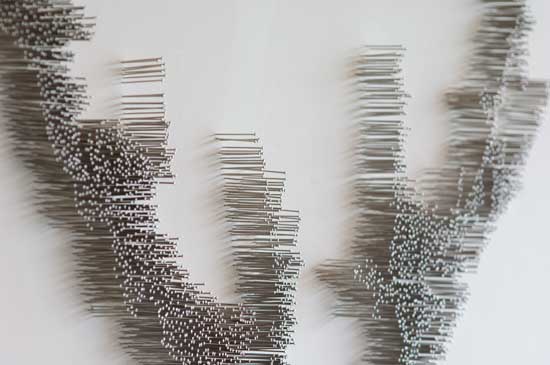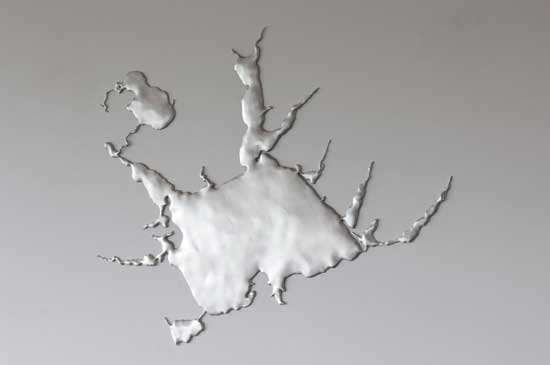In the sun-drenched lobby of Parrish Art Museum in Water Mill this summer, the artist Maya Lin explores the environment in three primary sculptural installations that examine the topographies, flood plains and waterways of our changing global ecology.
In “Platform: Maya Lin,” on view through October 13, the artist celebrates the landscape and maps the ecological contingencies brought about by climate change in poetic works that portray the fragile, watery sublime of our local community and the broader natural world.
.

Installation shot of "Platforms: Maya Lin."
.
In Pin River — Sandy, Lin examines the devastating course of Superstorm Sandy, the largest and most deadly hurricane of the 2012 Atlantic hurricane season. For those of us living along the eastern seaboard, the memory is still fresh and the shared sense of vulnerability is acute. Pin River — Sandy, a sprawling homage to this new precariousness, spans some 12 feet of white wall. Lin’s installation consists of thousands of straight pins—17,000 to be exact—that chart the boundaries of flood plains along Sandy’s path.
In a synthesis of complex geographical data, the pins transform the reality of this monstrous weather event into a diaphanous, hypnotic visual experience. Lin moves through the details of this brutal tempest like a cultural pointillist, fusing idea, data and perception into an image field that hums with artful and incisive discourse. Its massiveness offers an effective point/counterpoint to the gigantic ecological dilemma facing our planet.
The pins, precise in both form and application, also possess an aspect that is mercurial, like the weather. As sun rakes across the long wall over the course of a day, the resulting shadows create an altogether separate visual event; one that is temporal and fleeting and introduces elements of the performative to this subtle ovation.
On the one hand, there is an inherent predictability to the sun and to the lacy network of cast shadows it coaxes, but it is still dependent on myriad external events, like a sundial. This sense of interconnectedness, the idea that for every action there is a reaction, is at the core of Lin’s oeuvre.
.

"Pin River - Sandy" by Maya Lin, 2013. Steel straight pins, 114 x 120 x 1 1/2 inches.
.

Detail of "Pin River - Sandy" by Maya Lin, 2013. Steel straight pins, 114 x 120 x 1 1/2 inches.
.
Maya Lin is one of the foremost artists of her time. Born in 1959, Lin met worldwide acclaim in 1981 when her design for the Vietnam Veterans Memorial public art project in Washington, D.C. was selected from a field of some 1,400 submissions. Still an undergraduate at Yale University, Lin was thrust into the limelight as she executed what would become one of the most significant memorial sites in the United States.
Initially, her minimal and non-traditional design was met with controversy, eventually winning the hearts of millions of Americans through its capacity to convert the tragic loss of so many lives into a transformative aesthetic and spiritual experience.
Over the three intervening decades since the installation of the Vietnam Veterans Memorial, Lin has created sculpture on a scale that ranges from the intimate to the monumental, with numerous architectural and environmental installations permanently sited across the U.S. and abroad. Her conceptual focus has consistently been trained on the landscape, creating visual and architectural works that deftly merge the rational with the transcendental.
Through systems of ordering and an affinity for the technological, the artist has transformed a lifetime of environmental advocacy into artworks that expand our field of knowledge, dazzle the senses and induce the intangible to reveal itself.
In the same gallery, wall sculptures made from recycled silver pay tribute to some of our local and most hallowed bodies of water. Long Island Triptych consists of three representations of Accabonac Harbor, Georgica Pond and Mecox Bay respectively. Glimmering like solder spills, the three works are executed with delicate precision and unambiguous detail, creating gem-like reliefs that remind us how precious and defenseless are these ponds and waterways.
.

"Accabonac Harbor" by Maya Lin, 2014. Recycled silver, 27 3/4 x 17 3/8 x 3/16 inches. Courtesy Pace Gallery, New York.
.

"Georgica Cove" by Maya Lin, 2014. Recycled silver, 21 x 17 3/8 x 3/16 inches. Courtesy Pace Gallery, New York.
.

"Mecox Bay" by Maya Lin, 2014. Recycled silver, 33 1/4 x 42 1/2 x 3/16 inches. Courtesy Pace Gallery, New York.
.

"Long Island Triptych" by Maya Lin, 2014. Recycled Silver.
.
Situated on the floor, three marble sculptures marry the central idea of ecological interdependence with elegiac clarity. Arctic Circle, Latitude New York City and Equator nest inside one another in concentric circles, separate but intertwined like egg and yoke. Each ring depicts the topography of a global position specific to their physical location. Around the top edges of the circumferences the marble is cut into the wavy geological patterns that reference oceanography and the invisible landscape below. The works are regal, like immense crowns.
.

"Arctic Circle," "Latitude New York City," and "Equator" by Maya Lin. Vermont Danby Marble, 2013-2014.
.

Detail of "Arctic Circle," "Latitude New York City," and "Equator" by Maya Lin. Vermont Danby Marble, 2013-2014.
.
Using sonar resonance scans and aerial and satellite mapping devices, Lin’s visual language here is one in which the connectivity of global geography is made manifest in this classic medium, utilized in the realization of sculpture since the ancients. As an element that is the result of geological phenomena in and of itself, the marble used here by Lin reasserts the concept that our planet is one world with a single circulatory system.
______________________________
BASIC FACTS: "Platform: Maya Lin" remains on view through October 13, 2014. The Parrish Art Museum is located at 279 Montauk Hwy, Water Mill, NY 11976. www.parrishart.org.
_______________________________
Copyright 2014 Hamptons Art Hub LLC. All rights reserved.
